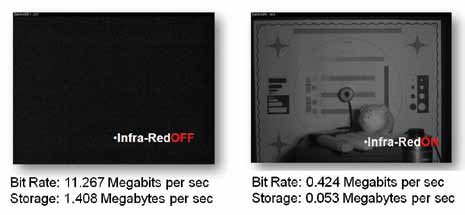Without good lighting, network and megapixel camera systems may not live up to their full potential. They may not be able to deliver quality images and — even worse — they risk becoming bogged down by the excessive video data that they generate.
Without good lighting, network and megapixel camera systems may not live up to their full potential. They may not be able to deliver quality images and — even worse — they risk becoming bogged down by the excessive video data that they generate.
Needs for lighting include reducing bandwidth usage, reducing storage space, enhancing video analytics and producing high-quality images. Lighting is even more critical with today's megapixel/IP systems than it was with the analog technology. The higher the resolution of the camera, the less sensitive it is, thus requiring increased light to deliver higherquality images during the hours of darkness.
 Good light levels are needed not only to ensure that every pixel is sufficiently energized — allowing the camera's resolution to be fully displayed — but, more importantly, to make sure that video compression works properly.
Good light levels are needed not only to ensure that every pixel is sufficiently energized — allowing the camera's resolution to be fully displayed — but, more importantly, to make sure that video compression works properly.
Video compression is an essential part of the megapixel camera's package because, without it, a lot more video data has to be transmitted and stored. The video stream of a network camera is transmitted through an Ethernet network . This transmission consumes a certain amount of bandwidth, and the more data there is, the more costly it becomes.
For network cameras, there are two main ways of lowering the bandwidth usage, either by sophisticated compression algorithms or by using appropriate lighting. Without good lighting — and therefore without effective video compression — a small number of megapixel cameras can place an excessive data load on a surveillance system's bandwidth and storage capability.
So the user has to pay more to increase the system's data-handling capacity, accept reduced transmission performance, resort to solutions such as reduced frame rate, or limit the number of cameras they monitor.
Lighting Makes a Difference As lighting does play a crucial role in capturing quality images at night, tests can be carried out to quantify what the real benefits of lighting are.
These tests should be conducted in a range of conditions — internal, external and dark box — and in all cases, a huge reduction in the amount of data generated by a well-lit scene, compared with a poorly lit or completely dark scene, should be observed.
In dark-box tests, bit rate and storage can be reduced up to 90 percent by adding IR light. In internal dark-room tests where ambient light might be available, bit rate and storage can still be reduced by around 80 percent by adding sufficient light.
 Data Burden?
Data Burden?
Without sufficient light, network cameras produce a very noisy image, exactly the same way as analog or digital still cameras do. The noise in the image prevents video compression from working correctly. This is because most compression techniques are based on the principle of only sending the updated data — that is, those parts of the image that have moved or changed (there is no point continually sending and storing the same data when a camera is looking at a static image). The problem is that even though the scene may be static, the compression software is tricked by the noise in a poorly lit scene into thinking that the whole image is “moving.” So, huge amounts of useless data from the noise are transmitted and stored.
Full Potential
The principles of good lighting should be followed to ensure that quality, even illumination is present across the whole scene. Lighting technology today is designed to make this easy and affordable, and to bring out the best performance in all surveillance cameras.
Lighting options are available for every application, from units specifically designed for dome cameras, to plug-and-play dedicated PoE lighting for network cameras, saving time and costs during installation.
Energy-efficient LED technology, which is long-lasting and maintenance- free, is now available and inexpensive to run. The benefits of good lighting are well-known to those working in the surveillance field; and moving into a converged, IP world, good lighting allows megapixel cameras to deliver high-quality images while reducing bandwidth and storage.